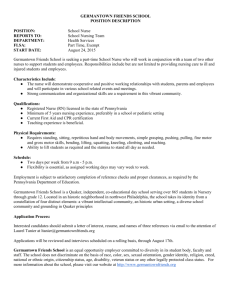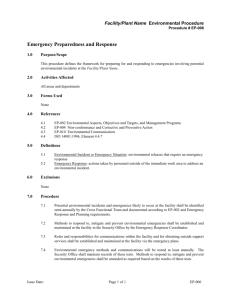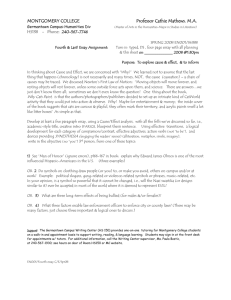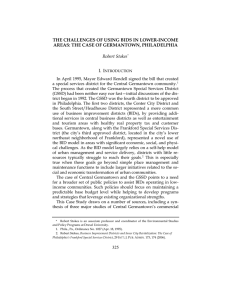TN - Vehicle Response SOP
advertisement
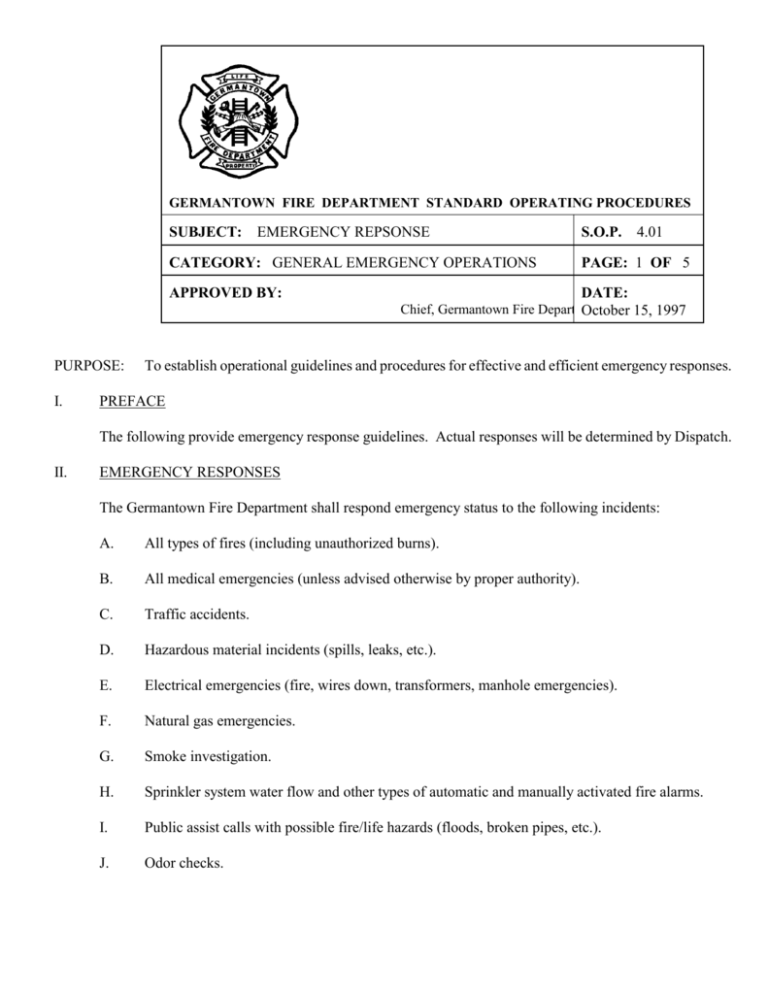
GERMANTOWN FIRE DEPARTMENT STANDARD OPERATING PROCEDURES SUBJECT: EMERGENCY REPSONSE S.O.P. 4.01 CATEGORY: GENERAL EMERGENCY OPERATIONS PAGE: 1 OF 5 APPROVED BY: DATE: Chief, Germantown Fire Department October 15, 1997 PURPOSE: I. To establish operational guidelines and procedures for effective and efficient emergency responses. PREFACE The following provide emergency response guidelines. Actual responses will be determined by Dispatch. II. EMERGENCY RESPONSES The Germantown Fire Department shall respond emergency status to the following incidents: A. All types of fires (including unauthorized burns). B. All medical emergencies (unless advised otherwise by proper authority). C. Traffic accidents. D. Hazardous material incidents (spills, leaks, etc.). E. Electrical emergencies (fire, wires down, transformers, manhole emergencies). F. Natural gas emergencies. G. Smoke investigation. H. Sprinkler system water flow and other types of automatic and manually activated fire alarms. I. Public assist calls with possible fire/life hazards (floods, broken pipes, etc.). J. Odor checks. GERMANTOWN FIRE DEPARTMENT STANDARD OPERATING PROCEDURES SUBJECT: EMERGENCY REPSONSE S.O.P. 4.01 CATEGORY: GENERAL EMERGENCY OPERATIONS PAGE: 2 OF 5 APPROVED BY: DATE: Chief, Germantown Fire Department October 15, 1997 K. Bomb threats when notified by Police (see policy on bomb threats). L. Elevator emergencies. M. Carbon Monoxide detector sounding, with or without reported occupant medical distress. SUBJECT: EMERGENCY RESPONSE S.O.P. 4.01 PAGE 3 OF 5 III. ROUTINE RESPONSES The Germantown Fire Department shall respond routine status to the following incidents: IV. A. Persons locked out of building (only when approved). B. Invalid assists (non-emergency). C. Move ups. D. Wash-downs (non-hazardous substances). E. Damaged or opened fire hydrants. F. Other non-emergency situations. INITIAL RESPONSE - ONE ENGINE The Germantown Fire Department shall respond one engine company on the following incidents: A. Public assists. B. Traffic accidents when requested (rescue vehicle also responds if a possible medical emergency exists). C. Odor checks. D. Automobile fuel leaks. E. Wash-downs. F. Trash fire, brush fire. G. Vehicle fire (unless structure is threatened). H. Electrical emergencies (unless structure fire or large electrical problem). I. Natural gas emergencies (unless gas leak is inside structure). J. Flammable fuel leaks (unless determined to be large quantity). K. Mutual aid responses. SUBJECT: EMERGENCY RESPONSE S.O.P. 4.01 PAGE 4 OF 5 V. L. Carbon Monoxide detector sounding, no medical distress. Rescue 41 shall also be dispatched if the caller reports people are in medical distress. M. As determined by Communications. INITIAL RESPONSE - TWO ENGINES The Germantown Fire Department shall initially respond two engine companies to the following incidents: VI. A. Gas filled structures. B. Explosions in structures. C. Bomb threats. (ONLY when requested by the Police Dept.) D. Other situations as determined by Communications. INITIAL RESPONSE - TWO ENGINES AND ONE LADDER COMPANY The Germantown Fire Department shall respond two (2) engine companies and one (1) ladder company to the following incidents: VII. A. Structure fires, single family. B. Commercial structure fires, with the exception of those determined to require other response. C. All multi-family dwellings. D. All hotels and motels. E. Those occupancies specified on the specials list as requiring two (2) engine companies and one (1) ladder company. TRUCK 41 Truck 41 will normally be manned by Reserve personnel. Truck 41 shall respond to all possible residential or commercial structure fires as soon as it is properly manned by a qualified driver and a fire fighter. If companies are already on the scene prior to the response of Truck 41, personnel manning Truck 41 shall advise Dispatch that Truck 41 is staffed and available. Dispatch shall notify the Incident Commander and ask if Truck 41 is needed. In the event of a working fire, Dispatch may automatically dispatch Truck 41 to the scene and notify the Incident Commander of such. SUBJECT: EMERGENCY RESPONSE S.O.P. 4.01 PAGE 5 OF 5 VIII.SAFETY IX. A. Multiple responding units should communicate with one another when approaching common intersections. B. Should emergency lights or sirens malfunction enroute to an alarm, the unit should notify the dispatcher and proceed to the alarm in routine response status, observing extra safety precautions. C. Seat belts and safety bars shall be fastened at all times on all responses, routine and emergency, and when returning to quarters. D. At railroad crossings without an electric signal all emergency equipment shall come to a complete stop. Emergency equipment shall yield and proceed with caution at railroad crossings with an electric signal which is not indicating an approaching train. E. Riding personnel on tailboard is strictly prohibited in all situations. RESPONSE CODES A. B. Emergency: 1. Urgent initial response on emergency incidents. 2. All emergency warning lights and headlights on. 3. Audible warning devices on and in use at all times. 4. Proceed expeditiously but in full control to insure public safety. 5 Adhere to all statutes governing emergency vehicle response. 6. When 1st arriving unit reports non-urgent situation, i.e. nothing showing, patient breathing, or the responding units are for additional alarms, the emergency response shall be a cautious response using all emergency warning devices, allowing for reduced speed and risks. Routine: 1. Non-emergency response without warning devices. 2. Proceed normal road speeds observing all traffic laws. 3. Headlights on. SUBJECT: EMERGENCY RESPONSE S.O.P. 4.01 PAGE 6 OF 5 X. XI. 4. Adhere to all statutes governing motor vehicles. SPEED RESTRICTIONS A. Fire equipment shall endeavor to maintain a desired response time by utilizing their best judgment as to speed consistent with existing traffic and weather conditions. B. Fire apparatus shall not exceed cautionary speed limits. Cautionary speed limits are displayed on warning signs. MULTIPLE VEHICLE RESPONSES A. The first vehicle out should completely clear the driveway before the second vehicle pulls out. B. Two or more vehicles traveling in the same direction shall maintain a 500 ft. distance between vehicles. C. If several emergency vehicles are approaching the scene of an emergency from different directions, extreme caution should be taken to avoid collisions at an intersection. Lieutenants should communicate with other responding units when approaching common intersections.
